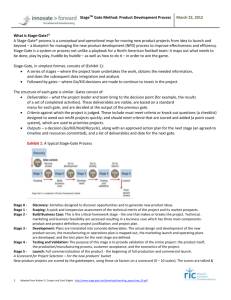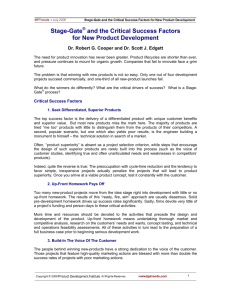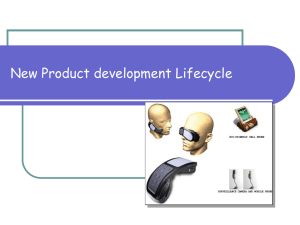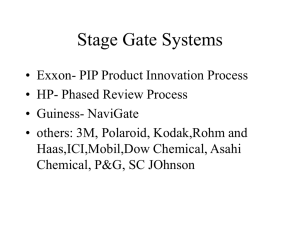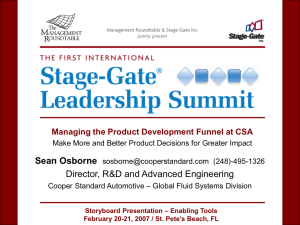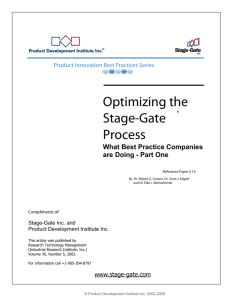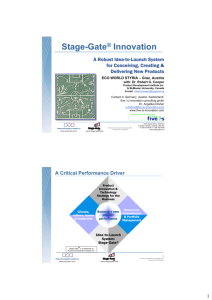10 Tips for Successfully Implementing a Stage
advertisement
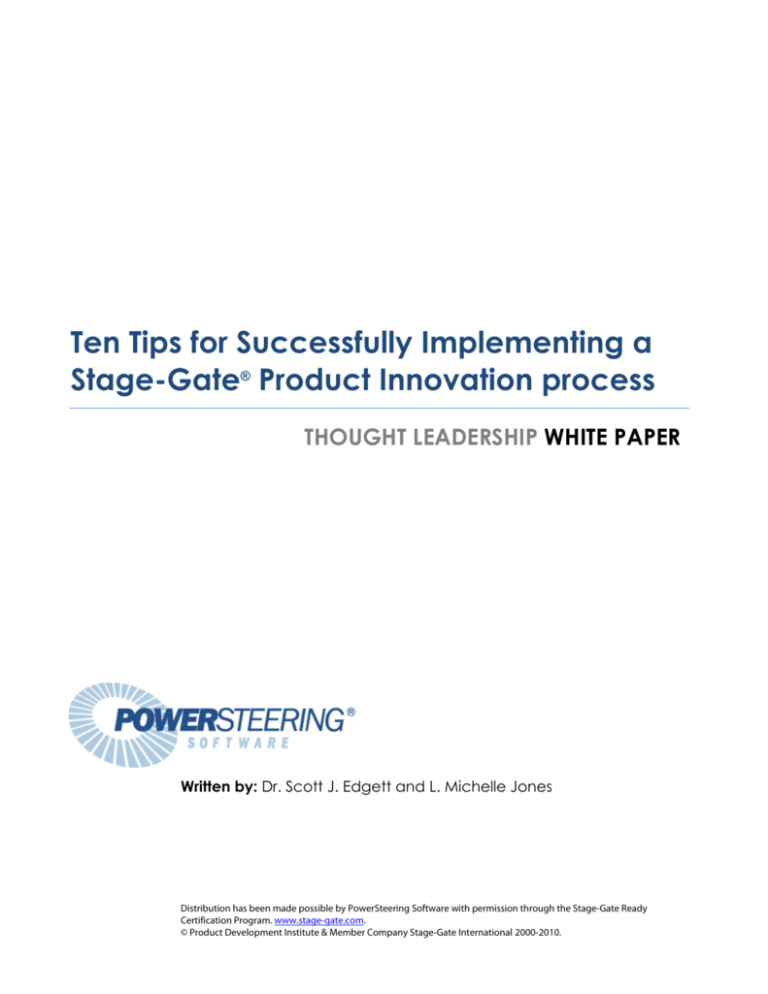
Ten Tips for Successfully Implementing a Stage-Gate® Product Innovation process THOUGHT LEADERSHIP WHITE PAPER Written by: Dr. Scott J. Edgett and L. Michelle Jones Distribution has been made possible by PowerSteering Software with permission through the Stage-Gate Ready Certification Program. www.stage-gate.com. © Product Development Institute & Member Company Stage-Gate International 2000-2010. Ten Tips for Successfully Implementing a Stage-Gate® Product Innovation Process Ten Tips for Successfully Implementing a Stage-Gate® Product Innovation process Do you have a strategic imperative to improve the results of your product development program? Do you have a mandate to implement a new product innovation process in your organization? Have you considered what will have a direct impact on how successful you will be? Have you developed a plan of attack to ensure success? Introducing a product innovation process is a critical step in improving the ability of your organization to achieve its organic growth targets. Numerous studies point to the common fact that the winners have in place a well designed and implemented Stage‐Gate process. Companies like P&G, Corning, Exxon and 3M all understand that to have a repeatable and successful product innovation program one critical ingredient is to have a solid innovation process. These organizations, and many others, also understand that to be successful you need more than just a well thought out process design. In fact that is only the starting part of the challenge as you undertake to improve what is a critical business activity. In this article we share the top ten lessons that have stood the test of time as different organizations have designed and implemented their own Stage‐Gate processes. Each of these tips will contribute to the speed of adoption and the ultimate ‘stickiness’ of the process within your organization. As product innovation is a critical competitive weapon in helping your organization achieve its strategic goals for growth, the effort invested in developing an implementation plan will yield repeated payoffs in the future. Product innovation is too important to be left to chance. Implementation of your new product innovation process is also too important to be left to chance. Each of the following tips is considered to be a best practice and should be carefully thought through and built into your implementation plan. Each tip, if successfully managed, will contribute to the successful implementation of your new Stage‐Gate process1. 1. Have a Well Designed, Credible Process Design Your first step is to ensure that you have a strong foundation: A well designed and credible Stage‐Gate process. This means ensuring that it is complete and meets the needs of your organization. While certain aspects of the process are unique to your industry or company there are many proven critical 2 © Product Development Institute Inc. 2000-2010 Ten Tips for Successfully Implementing a Stage-Gate® Product Innovation Process success factors that are built into good processes. These have been vetted by solid research and thousands of other organizations that have gone before you2.. A well designed process is the foundation of all that comes after. If it is well thought out with the right activities in each stage and an effective decision‐making framework then the organization will be more receptive to the new process. Your colleagues will use it and decide for themselves if it is an improvement over past internal practices. The more positive the reviews and results, the quicker it will be adopted throughout your company. Typical steps to ensure you design a good process are: A cross‐functional team develops the process. Product innovation is a complex business‐ wide concern that impacts many functional areas within the organization. You need their input and experience. You understand the strengths and weakness of your current process. Have the team critically assess what is and is not working in current approaches. Ensure the new process preserves what has made you successful in the past and replaces the past failure points with improved practices. Learn from your past so it is not repeated going forward. Your team is objective: Encourage the team to look at and benchmark other companies. Purchase a benchmarking report on top performing organizations, or consult one of the many experts on the subject. Many best practices have been well defined, and it is important to capture as many of these as possible. Looking outside your company encourages your team to view objectively the gap between where you are today and where you want to be. Your team is mandated to develop a process capable of driving better performance results. Encourage the team to seek new and better ways of working and to avoid making internal compromises or succumbing to internal politics. Example: A common fail point of some organizations is to launch a poorly developed process and try to fix it moving forward. In the end, they pay a heavy price because the new process does not deliver the desired result. This is a costly misstep. Not only will the company have to repeat work it has already paid for through the redesign and re‐launch of the process but it has likely lost valuable ground to competitors. Early warning signs of trouble include a team too rushed to conduct proper best practice research; lack of senior management sponsorship; ineffective application of the critical success factors; too many political compromises and, failure to actually change the ‘way we do business’. 2. Give Visible and meaningful Leadership Support 3 © Product Development Institute Inc. 2000-2010 Ten Tips for Successfully Implementing a Stage-Gate® Product Innovation Process What is important to the Leadership Team is important to everyone else. Similar to all other major initiatives if the Leadership team is strongly behind the initiative then the chances of success will improve dramatically. Successful product innovation is critical to the business strategy of your organization. Best in class companies get this. Their executives are completely involved in implementing their new processes. Everyone in these companies knows the manner in which they implement innovation will be critical to business success. The leadership team “walks the talk”. Some ways to engage the senior team include: A leadership team that publically supports the initiative and explains why it is critical to the future of the company. Have the CEO or another senior executive launch the initiative in a ‘kick‐off’ event with the team. One senior executive acts as executive sponsor for the project. This demonstrates support to the project leader. The executive team receives regular updates on progress. This keeps them familiar with process design and also allows them to provide valuable guidance or resolve tough issues. You ensure they understand what is different from the past and how it will affect their respective parts of the organization. Each executive becomes a champion of the new process in their respective functional areas. In best practice companies, the leadership spearheads the charge for product innovation. They know how important it is to the future. They also understand how difficult it can be to install change within the organization. The impact of their visible and meaningful support cannot be understated. 3. Be sure You Have Sufficient and Appropriate Resources Although it may seem obvious you would be surprised by how many organizations that have tried to implement new processes without assigning enough resources to get the job done properly. If product innovation is that important to your organization, and if past results have not been good enough, then why risk trying to do your new process on the cheap? You need to assign your best people to the project and give them the time they need to do the work. Here are some resourcing tips: Be sure you understand the actual resources you will need, including both skills and time requirements. Be sure the people assigned to the project have the time allocated to do the work needed. They cannot do their ‘day job’ and this project as well. 4 © Product Development Institute Inc. 2000-2010 Ten Tips for Successfully Implementing a Stage-Gate® Product Innovation Process Identify people with a passion for this project: people that really want to see an improved process developed and implemented in the organization. Part the team mandate should be to develop a carefully thought out internal launch plan for the new process. Be sure your executives and team agree on a solid launch plan, and then commit the resources necessary. Best practice companies devote a lot of time and energy both to the design and to the implementation of the new process. It is expected that the new process will change the way people work and, as such, requires the resources and skills needed to be successful. Example: One company, trying to improve their process, asked each functional area to assign a person to the team. In retrospect management realized that most of the assigned team members were people that the functional area could do without for a period of time. As you can probably guess this team did not produce very good results, they simply lacked the expertise and experience needed to do the job. Unfortunately the company lost another critical year as they undid the damage. 4. Create Defined Roles and Responsibilities Implementing a Stage‐Gate process is usually a significant cultural adjustment for organizations. It, therefore, requires that many people at many levels contribute to making the change happen. Employees rarely feel comfortable with change. Successful companies ensure their people know in advance the roles and responsibilities they will have within the new process. Providing clarity around the roles and responsibilities makes it much easier for people to see how they can contribute, and makes it more likely that they will be strong supporters of the new way of doing business. You will need to focus on some key roles: Executive Sponsor and Process Manager. These people will champion the implementation of the process. Gatekeepers. They are the decision makers. Project Leaders and Team Members. These are the new product developers. People in these roles will inevitably fall into one of three categories: they will prevent your initiative from happening, will let it happen, or will make it happen. If you want them to fall within the last category, you will need to define their roles and describe their responsibilities in 5 © Product Development Institute Inc. 2000-2010 Ten Tips for Successfully Implementing a Stage-Gate® Product Innovation Process such a way that each player not only understands their new role but also understands how to be successful. Assume that everyone will need some level of training, mentoring or guidance. Successful companies ensure clarity around roles through written role responsibilities specifying the boundaries and articulating how the roles interface with each other. 5. Have a Strategic Implementation Approach Thinking strategically about your process implementation is critical for managing expectations and getting the buy‐in you need. There is something to the saying that the first 100 days are critical. During this introduction period you have people’s attention, and goodwill. You can capitalize on the sense of urgency that this creates. This period also permits you to demonstrate to the organization that the new initiative is real and strategically important. Hence the need to demonstrate that the initiative is being embraced at all levels in the organization. Some helpful tips are: Select an approach that suits your goals and capabilities, recognizing this effort requires support from multiple parts of the company. Understand the degree of change that will occur. The greater the degree of change, the higher the risk of failure, and the more detailed and thought‐out the launch plan will need to be. Consider the types of behavioral change required and what will have to occur to enable it. Plan for some early wins that can be attributed directly to the new process – everyone likes to win. Develop a detailed plan to launch the new process. Manage it the same as you would any other project. Given the impact a successful or unsuccessful launch can have it is well worth the management time to ensure it is a success. Note that if you are using a vendor for your automation needs then be sure their role is well defined and that they are well versed in the launch plan and how their timely contribution will contribute to the project’s success. Example: The team in one company had developed a comprehensive launch plan and presented it to the Leadership team for approval. Unfortunately this executive group did not understand the magnitude of change that was going to be required in the organization. 6 © Product Development Institute Inc. 2000-2010 Ten Tips for Successfully Implementing a Stage-Gate® Product Innovation Process Their view was this was a very logical process that seemed to be very straight forward. Hence they could not see the value in approving the time and budget requested for training people. They also shortened the launch time feeling that people were doing many of these types of activities already and hence decided it was a low risk (they seemed to have forgotten that if it was all so easy then why was the failure rates so high in previous new product launches). As you might guess this company had a difficult time in gaining support for the new process. 6. Be Effective with Your Communication and Marketing Can there be such a problem as over communicating? If so, it is a rarity. Project teams implementing large change initiatives such as Stage‐Gate usually devote significant time to researching, evaluating and designing their new process. Through this effort, they increase their knowledge and comfort‐level in the topic. Often, when the team is ready to implement the initiative to a larger audience or community, they are so comfortable with the concept that they underestimate the need to sell it to others. They simply ‘unveil’ their work, expecting that everyone will be as excited as they are. Convincing others to not only participate in the new initiative but to find their own ways to contribute requires a well‐thought‐out communication and marketing plan. This plan should not only inform and educate but should generate excitement and maintain momentum throughout the life of the process. Some tips to effectively communication and market the process include: Develop your communication plan early to ensure you have access to the agendas of critical meetings, to book senior executives to deliver presentations pertaining to your Stage‐Gate initiative and to be creative. Follow the three ‘C’s of communication: Clear, Concise and Continuous. The process will not sell itself; people need to understand what it means and how it affects them personally. Answer the “so what?” question Make sure documentation is ready and easily accessible Listen to the feedback you receive. There will be areas identified for improvement, or where more clarity is needed. Example: One creative company launched their Stage‐Gate Process and supplied every staff member with a ‘Passport to Success’. The passport booklet very cleverly included brief, but key information about the new Stage‐Gate process including: a colorful diagram illustrating the stages and gates, an overview of the purpose and activities in each stage and a temporary hotline phone number that people could contact with their questions. This illustrated just how critical the initiative was to the company and it ‘marketed’ the new initiative to help all stakeholders ‘buy in’ and contribute to the process. 7 © Product Development Institute Inc. 2000-2010 Ten Tips for Successfully Implementing a Stage-Gate® Product Innovation Process Create a master communication planning chart outlining: key stakeholder groups, the specific content they are interested in, the intent of the information (e.g. educational, persuasive), the media most likely to be accessible to them (e.g. newsletters, websites, email, meetings, etc.), the reaction and action(s) you want them to take after reading communications and the frequency of communication required. 7. Track Your Performance What gets measured gets done. It really is that simple. During the design phase the team should identify several key process adoption metrics that will measure the adoption rate and success of the new process. Create a starting baseline and select target dates for subsequent measurement. Some tips for selecting your metrics: Use process metrics designed to measure the effectiveness of the process implementation (e.g. percentage of projects enrolled in the Stage‐Gate process, adoption rate; frequency and quality of gate meeting). Use metrics that define impacts on new product performance (e.g. time‐to‐profit; new product success rates). The metrics should align with the original mandate for your effort: What you set out to improve. It is important to know a year down the road if improvement has occurred. The metrics should be specific, measurable, actionable, relevant and timely. Communicate the metrics. Share the knowledge on how you are doing. Be sure your list of metrics is concise. Too many metrics are costly, and they raise a red flag that the team is not in agreement about key outcomes. The clearer the metrics the easier it is for people to understand what is important and what the new process is trying to accomplish. This, in turn, makes it easier for them to understand how they can support the initiative. 8. Appoint an Executive Sponsor of the Product Innovation Program Rarely has an organization been able to declare the successful implementation of Stage‐Gate, without noting the significance of the Executive Sponsor. Absolutely critical to success, the Executive Sponsor is the visionary for the Product Innovation Program, both from the short and long term perspective. Preferably a senior executive, the sponsor is able to contribute to business strategy through the development of an ambitious innovation plan for growth through new products. The sponsor relies less on the authority of title and more on capability to inspire an organization to participate and contribute to a grand plan of challenging, yet exciting change. 8 © Product Development Institute Inc. 2000-2010 Ten Tips for Successfully Implementing a Stage-Gate® Product Innovation Process Some tips for identifying your sponsor include: Understanding that the role of the sponsor is not all vision, fun and games. The sponsor also takes on the challenging task of guiding colleagues, the members of the senior executive team, through change. Find a sponsor who will be a role model. A truly successful implementation is evidenced by visible and demonstrated support for the new way of working. Look for an executive who is willing to call colleagues on inappropriate behavior and have the courage and fortitude to openly discuss performance issues that ultimately result in action. Seek a sponsor who is knowledgeable and well‐versed in the mechanics of the Stage‐ Gate process and is often the subject matter expert to the Senior Executives. This person will incorporate new Stage‐Gate language into the company vocabulary, will establish ongoing communications with the Process Manager and will working closely with each executive leader to ensure they are successful in their role. 9. Understanding the Impact on Your Company’s Culture and Systems Never underestimate the willingness of people to reject change. Understand your company’s culture and what your challenges are going to be. One way to get started is to review some past change management initiatives, asking several key questions: “How successfully have we been in the past and why?” “How or what can we do differently this time to be more successful?” This should lead your team into a good discussion around the various company stakeholders, the impact the change will have on them, and the resources needed. Some tips for researching your company’s culture include: Conduct a risk and barrier analysis of the key stakeholders. Understand where the high risk areas might be and what barriers exist that will need to be overcome. Understand what other processes will be affected, how your new process will work with those processes, and who will be responsible for managing that aspect of the change. Be sure to examine various levels and functional areas. Each group will have its own. Example: Within one organization it was well known that most changes in the past have been ‘flavor of the month’ that would eventually be phased out if ignored long enough. The innovation process team recognized that they would be up against this mentality again as they rolled out their new product process. To help overcome resistance to change they identified a number of key individuals in each functional area and level of management. 9 © Product Development Institute Inc. 2000-2010 Ten Tips for Successfully Implementing a Stage-Gate® Product Innovation Process They then created a plan to approach each individual separately and discuss the initiative with them with the goal of gaining their support as informal leaders within their groups. This approach, while it took a little longer, proved to be very successful. As each influential person was brought on board, they in turn became ambassadors for the new initiative. The end result was a well received product innovation process when it was launched. By respecting the past and learning from it the team was able to move the organization forward. 10. Seek Effective Change Management Change management done properly can yield extremely impressive results. Essentially, an effective change management program can enable people fulfilling the critical roles in Stage‐ Gate such as the Gatekeepers, Project Leaders and Team Members to transition through the change process much more quickly and effectively. This means achieving greater direct contribution in a much shorter period of time and, of course, this means results! As people begin the learning curve, they spend more time internalizing the new process and less time thinking about executing the actual activities associated with the new product project. This means, initially, they are not as efficient. An organization begins to develop new product development as a core competency when their entire community of new product developers moves beyond simply following new process instructions to seamlessly and effectively contributing to all aspects of their new product development process. This is particularly critical for organizations with limitations on time, or product development resources, and of those requiring significant degrees of change to their culture. Some tips for managing change include: Do not underestimate the amount of change management that is involved. Communicate positive messages and why it is important for the organization to continually aspire to greater heights. People accept change better if they understand why it is needed. Acknowledge and reward those people who support the new Stage‐Gate process and the new activities and behaviors associated with it. Recognize that some people will be ‘neutral’ and with some effort can become supporters. Recognize that some people will be ‘neutral’ and with some effort can become supporters. Develop a plan and be prepared to adjust it as needed. 10 © Product Development Institute Inc. 2000-2010 Ten Tips for Successfully Implementing a Stage-Gate® Product Innovation Process Conclusion Many organizations have gone before you to implement successful product innovation processes. As a result, there are many best practices that you can leverage to improve your chances for success. We have set out the key ones here. You can take each of the ten tips given in this article and ask your design and implementation team incorporate them into their plans. By implementing a new Stage‐Gate process into your organization, you are presenting it with the opportunity to make huge gains in product innovation capabilities. A high quality process will enable your organization to do the right things at the right time for the right reasons. 11 © Product Development Institute Inc. 2000-2010 Ten Tips for Successfully Implementing a Stage-Gate® Product Innovation Process ABOUT THE AUTHORS Dr. Scott J. Edgett & L. Michelle Jones Dr. Scott J. Edgett is internationally recognized as one of the work’s top experts in product innovation and is the pioneer of portfolio management for product innovation, He is a high profile speaker and sought‐after consultant. Dr. Edgett has had extensive experience working with large multinational clients in a variety of industries, principally focusing on issues affecting innovation leadership and capability. His is credited with helping business executives and innovation professionals successfully implement world‐class innovation processes that have generated outstanding results. His speaking engagements and consulting work have taken him around the globe to work with some of the worlds best innovators and companies among the Fortune 1000. Dr. Edgett is Chief Executive Officer and co‐founder with Dr. Robert Cooper of both Product Development Institute Inc. and Stage‐Gate International. He has spent more that 20 years researching and developing innovation best practices and working with organizations in product innovation. He is a prolific author having co‐authored six books, including the popular “Portfolio Management for New Products, Second Edition”, and has published more than 60 academic articles. Dr. Edgett is a former Professor of the Michael DeGroote School of Business, McMaster University and a Faculty Scholar at the Institute for the Study of Business Markets (ISBM), Penn State University. Michelle Jones is Executive Vice President of Global Growth at Stage‐Gate International She leads the commercialization of some of the world’s best practice research on product innovation into state‐of‐the‐art products and services for companies striving to achieve product innovation excellence. Formerly the Head of Consulting Services at Stage‐Gate International, Michelle has worked with an impressive portfolio of companies and has over 15 years of experience across several industries including Aerospace, Automotive, Chemical, Consumer Packaged Goods, Defense, Electronics, Food, Financial, Manufacturing and Medical. She has led numerous large‐scale, complex projects to success including initiatives spanning every critical aspect of the Product Innovation Diamond (Strategy, Portfolio Management, 12 © Product Development Institute Inc. 2000-2010 Ten Tips for Successfully Implementing a Stage-Gate® Product Innovation Process Stage‐Gate System, and Leadership/Culture). She is an authority on the topic of Product Innovation. Michelle holds a Masters of International Business Administration degree from the University of Western Ontario, a Bachelors of Business Administration degree and Advanced Project Management from McGill University, Montreal, Canada. Michelle is a certified New product Development Professional (NPDP) with the PDMA, and author and seminar leader References Some parts of this article are taken from and or incorporate content from “Successfully Implementing the Stage‐Gate NPD Process” by L. Michelle Jones and Barbara Pitts, Visions Vol. 27, No. 2, 2003. 2These studies are summarized in: R. G. Cooper, ʺNew Products: What Separates the Winners from the Losers,ʺ Chapter 1 in: The PDMA Handbook of New Product Development, 2nd edition, New York, NY: John Wiley & Sons 2004; also: R. G. Cooper, Winning at New Products: Accelerating the Process from Idea to Launch, 3rd edition. Reading, MA: Perseus Books, 2001, Chapters 2 and 3. See also Cooper, R.G., Edgett, S.J. and Kleinschmidt, E.J. “Optimizing the Stage‐Gate Process: What Best Practice Companies are Doing”. Research Technology Management 45, 5, 2002. 1 13 © Product Development Institute Inc. 2000-2010 ABOUT POWERSTEERING SOFTWARE PowerSteering Software is the leader in SaaS PPM software for managing Information Technology, Lean Six Sigma, Project Management Offices and other enterprise initiatives. Our easyto-use software provides executives at the US Department of Defense, Ingersoll Rand, Merck, UK Highways Agency, and over 140 other customers with executive visibility, strategy alignment, and enhanced team productivity to drive strategy and accelerate results. For additional information, please visit www.powersteeringsoftware.com or call us at 617-492-0707 (tollfree 866-390-9088). Distribution has been made possible by PowerSteering Software with permission through the Stage-Gate Ready Certification Program. www.stage-gate.com. © Product Development Institute & Member Company Stage-Gate International 2000-2010. Ten Tips for Successfully Implementing a Stage-Gate produc Innovation Process Want to Learn More? Dr. Robert G. Cooper and Dr. Scott J. Edgett invite you to attend their Product Innovation Best Practice Seminars Successfully Designing and Implementing the Stage-Gate® Process - A Best Practice Approach Winning At New Products - Achieving New Product Success with Best Practices Developing A Product Innovation Strategy and Deciding Your New Product Portfolio - Making Strategic Choices and Picking the Winners Generating Breakthrough New Product Ideas - Feeding the Innovation Funnel Advanced Techniques for Accelerating the New Product Process for Maximum Productivity Best Selling Books Books by Dr. Robert G. Cooper and Dr. Scott J. Edgett which address the complex issues surrounding product innovation. Stage-Gate International Knowledge Community Receive Dr. Cooper and Dr. Edgett’s latest research, information and tips that keep you current in Product Innovation. Be the first to receive advance copies of new articles, research papers, books, seminars and more. Join for free at www.stage-gate.com/subscribe.php 15 www.stage-gate.com +1-905-304-8797
